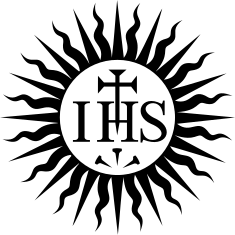Jesuits in the United States
Jesuits are members of the Roman Catholic order Society of Jesus founded by Ignatius of Loyola in Spain in 1540. In the United States it is best known for its missionary activities to Native Americans, its network of colleges and universities, and (in Europe before 1773) its politically conservative role in the Catholic Counter Reformation
Missions to the Indians
Most of the Jesuit missions to North America were located in today's Canada, but they explored and mapped much of the west.[1][2] French missionaries Père Marquette and Louis Jolliet were the first Europeans to explore and chart the northern portion of the Mississippi River, as far as the Illinois River.[3]
Peter De Smet was a French Jesuit active in missionary work among the Plains Indians in the mid-19th century. His extensive travels as a missionary were said to total 180,000 miles. He was known as the "Friend of Sitting Bull" because he persuaded the Sioux war chief to participate in negotiations with the United States government for the 1868 Treaty of Fort Laramie.
History
It was a crime for Jesuits to enter colonial Massachusetts, but none were known to be present there. There were about two dozen Jesuits in the Thirteen Colonies in 1760, and they kept a low profile.[4]
Former Jesuit John Carroll (1735–1815) became the first Catholic bishop in the young republic. He founded Georgetown University in 1789, and it remains a pre-eminent Jesuit school.[5]
Stephen Larigaudelle Dubuisson, S.J. (1786–1864) was sent by the Jesuits from France to the United States in 1816-26. He served in several parishes and colleges in the Maryland-Pennsylvania area, the center of Catholicism in the new nation. He was not a success as the head of Georgetown College, but otherwise was highly energetic and generally successful. In 1826 he was recalled to Rome, where he became effectively in charge of all Jesuits in the United States, as the advisor on American affairs to the head of the Society. He handled fund-raising, appointments, and setting general policies.[6]
The American Jesuits were restored in 1804, and intellectually reflected the English Enlightenment, emphasizing reasonableness of faith, the right of individual conscience, private devotion, and active participation in the political life of the Republic. In Europe, by contract, the Jesuits were restored in 1814, as part of the Bourbon reaction against the French Revolution. The restored order "resisted intellectual innovation, distrusted Republicanism, championed papal primacy, clung to the throne/altar alliance, and promoted a Baroque piety that was 'warm, emotional, colorful and ardent.'"[7] The European and American models were incompatible, and a flood of European Jesuits overwhelmed the new nation and established its conservative policies. In 1864, they wholeheartedly adopted the "Syllabus of Errors" an encyclical from Pope Pius IX that named 80 specific modern liberal ideas that Catholics were forbidden to teach or believe in.[8] The Jesuits were quite successful in establishing staffing, funding and enrolling students for a growing network of secondary and collegiate schools. As the Irish and German ethnic middle classes became better established, they sent their boys off to Jesuit schools. The main goals of the Jesuit education were to inculcate piety, loyalty to the church, and strict adherence to the rules. The chief intellectual pursuit was Thomistic philosophy. Catholic students were not allowed to attend lectures given by non-Catholics.[9] As late as the 1950s, Catholic writers such as John Tracy Ellis were bemoaning The intellectual weakness of the Catholic community.[10]
The late 19th century, the reform element emerged among Catholics, led by Archbishop John Ireland, that was Strongly opposed by conservative elements, led by the Jesuits. One battle involved creation of the Catholic University of America, in Washington, which would compete directly with the nearby Jesuit school Georgetown University. The dispute lasted for decades, and weakened both schools.[11]
See also
Notes
- ↑ Allan Greer, ed. The Jesuit relations: natives and missionaries in seventeenth-century North America (2000).
- ↑ Nicholas P. Cushner, Why have you come here?: the Jesuits and the first evangelization of native America (Oxford UP, 2006).
- ↑ Reuben Gold Thwaites, Father Marquette (1902).
- ↑ Kathleen A. Mahoney, Catholic Higher Education in Protestant America: The Jesuits and Harvard in the Age of the University (2003) p 47/
- ↑ Robert Emmett Curran, The Bicentennial History of Georgetown University: From Academy to University 1789-1889 (Georgetown UP, 1993).
- ↑ Cornelius Michael Buckley, Stephen Larigaudelle Dubuisson, S.J. (1786–1864) and the Reform of the American Jesuits. (2013)
- ↑ Marianne Gallagher, "The Jesuits at Boston College in the Late Nineteenth Century," American Catholic Studies (2007) 118#2 pp. 43-66 online quote on p 45; she took the 'warm' quote from Owen Chadwick, Secularization and the European Mind in the Nineteenth Century (1975) pp. 117-18.
- ↑ Darrell Jodock (2000). Catholicism Contending with Modernity: Roman Catholic Modernism and Anti-Modernism in Historical Context. Cambridge UP. pp. 18–20.
- ↑ Gallagher, pp 43-45.
- ↑ John N. Kotre (1978). The Best of Times, the Worst of Times: Andrew Greeley and American Catholicism, 1950-1975. p. 31.
- ↑ Vincent J. Gorman, "Georgetown University: The Early Relationship with the Catholic University of America 1884-1907." Records of the American Catholic Historical Society of Philadelphia 102#3 (1991): 13-31. online
Further reading
- Curran, Robert Emmett. The Bicentennial History of Georgetown University: From Academy to University 1789-1889 (Georgetown UP, 1993).
- Cushner, Nicholas P. Soldiers of God: The Jesuits in Colonial America, 1565-1767 (2002) 402 pp.
- Garraghan, Gilbert J. The Jesuits Of The Middle United States (3 vol 1938) covers Midwest from 1800 to 1919 vol 1 online, ; vol 2; vol 3
- McDonough, Peter. Men astutely trained : a history of the Jesuits in the American century (1994), covers 1900 to 1960s; online free
- Schroth, Raymond A. The American Jesuits: A History (2009)
- Sutto, Antoinette. "Lord Baltimore, the Society of Jesus, and Caroline Absolutism in Maryland, 1630–1645." Journal of British Studies 48.3 (2009): 631-652.

